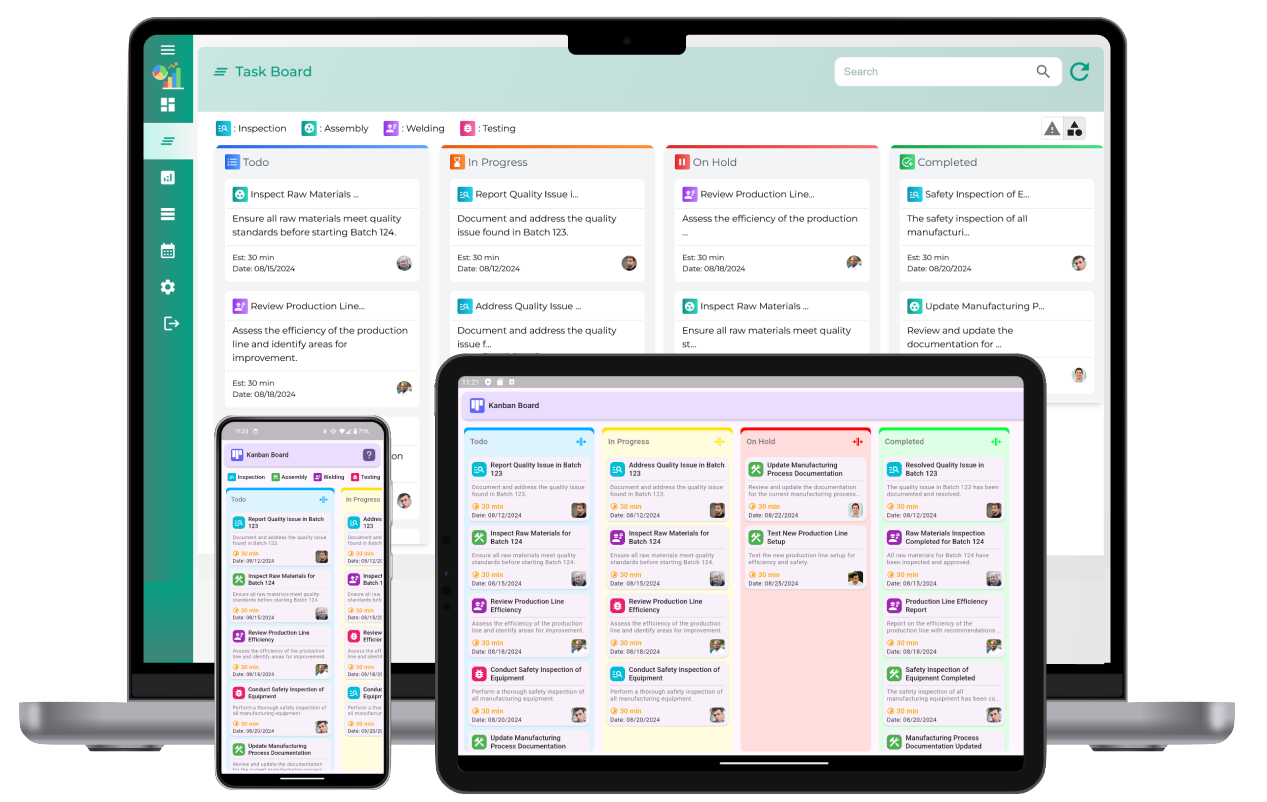Kanban is a visual workflow management system that helps manufacturing industries streamline production processes, reduce waste, and improve efficiency. By implementing Kanban in manufacturing, businesses can optimize workflow, enhance communication, and ensure smooth production cycles.

1. Understanding Kanban in Manufacturing
Kanban originated from lean manufacturing principles and is widely used to control work-in-progress (WIP), balance supply and demand, and prevent bottlenecks in production. In a manufacturing setting, Kanban uses visual signals, such as cards or digital boards, to manage tasks and materials efficiently.
2. Key Benefits of Kanban in Manufacturing
- Improved Workflow: Reduces delays and ensures a steady production pace.
- Reduced Waste: Minimizes excess inventory and material waste.
- Enhanced Visibility: Provides real-time insights into production progress.
- Better Resource Allocation: Ensures optimal utilization of workforce and materials.
- Increased Efficiency: Helps teams focus on high-priority tasks and reduce downtime.
3. How to Implement Kanban in Manufacturing
Step 1: Define Workflow Stages
Start by mapping out the different stages of the production process. Common stages include:
- Raw Material Procurement
- Production Planning
- Manufacturing
- Quality Inspection
- Packaging and Distribution
Each stage should be clearly defined to ensure smooth transitions between processes.
Step 2: Set Work-in-Progress (WIP) Limits
WIP limits help control the number of tasks or items in each stage of production. Setting WIP limits prevents overloading a specific stage and ensures steady workflow management.
Step 3: Use Kanban Boards for Visualization
Kanban boards help teams track work progress visually. A Kanban board typically consists of columns representing different workflow stages and cards representing tasks. As work progresses, cards move from one column to the next, providing real-time updates on production status.
Step 4: Establish Pull System
Unlike traditional push-based manufacturing, Kanban follows a pull-based approach. Work is only started when there is demand, reducing excess production and ensuring that resources are used efficiently.
Step 5: Continuously Improve
Regularly review the Kanban system and analyze performance metrics. Identify bottlenecks, optimize processes, and make necessary adjustments to improve productivity.
4. Digital Kanban Systems for Manufacturing
Modern manufacturing facilities leverage digital Kanban boards to automate workflow tracking and improve collaboration. Digital systems provide real-time data analytics, automated notifications, and integration with existing enterprise resource planning (ERP) systems.
5. Common Challenges in Kanban Implementation
While Kanban offers several benefits, some common challenges include:
- Resistance to change among employees.
- Difficulty in setting appropriate WIP limits.
- Need for continuous monitoring and adjustments.
By addressing these challenges through proper training and support, manufacturers can successfully implement Kanban and achieve operational excellence.
Kanban for manufacturing: Simplifying workflow and boosting productivity
What is Kanban in manufacturing?
Kanban is a visual workflow management system used in manufacturing to optimize production processes and reduce waste.
How does Kanban improve workflow efficiency?
Kanban improves efficiency by ensuring tasks are completed in sequence, reducing bottlenecks, and preventing overproduction.
What are the key principles of Kanban in manufacturing?
Kanban is based on visualizing work, limiting WIP, managing flow, making process policies explicit, and continuous improvement.
How does a Kanban system work in a production environment?
In a manufacturing setting, Kanban signals when to produce, move, or replenish materials, keeping production smooth and efficient.
What are the main components of a Kanban system?
Key components include Kanban boards, cards, WIP limits, pull signals, and continuous process monitoring.
How does Kanban help reduce waste in manufacturing?
Kanban minimizes waste by controlling inventory levels, avoiding excess production, and improving material flow.
What are work-in-progress (WIP) limits in Kanban?
WIP limits restrict the number of tasks or production units that can be worked on at a time to prevent overloading.
How does Kanban support just-in-time (JIT) production?
Kanban ensures materials are replenished only when needed, reducing excess inventory and supporting JIT manufacturing.
Can Kanban be used in both small and large-scale manufacturing?
Yes, Kanban is scalable and can be adapted to suit the needs of both small workshops and large production facilities.
How do Kanban cards function in a manufacturing workflow?
Kanban cards act as signals for production teams to start, stop, or move materials through different stages.
How does Kanban help in inventory management?
Kanban keeps inventory levels optimal by replenishing stock based on actual demand instead of forecasts.
What are the benefits of using Kanban in manufacturing?
Kanban improves productivity, reduces lead times, enhances flexibility, and minimizes overproduction.
What challenges can arise when implementing Kanban?
Challenges include resistance to change, improper WIP limits, and difficulties in maintaining real-time updates.
How do you measure the success of a Kanban system?
Success is measured using metrics like lead time, cycle time, throughput, and defect rates.
What are the best practices for maintaining an efficient Kanban system?
Best practices include regular review of processes, continuous team training, and adapting Kanban rules to evolving needs.